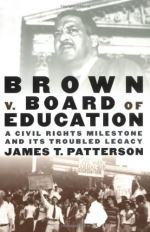|
This section contains 835 words (approx. 3 pages at 400 words per page) |

|
Summary
Blacks and white liberals in the 40s and 50s challenging racism saw the race relations in the United States in a new way. Early influence voices included Gunnar Myrdal, President Harry Truman and Thurgood Marshall. The most powerful forces behind change were the rise of black militancy; the activism of Thurgood Marshal and the NAACP; and, the white voices like Truman and Myrdal speaking out.
Membership in the NAACP grew from 50,000 in 1940 to 450,000 in 1946. Fair employment practices laws were implemented in eleven states and numerous cities. Eighteen states formally called for the end of racial discrimination in public facilities. Blacks made progress in elections in the south, winning campaigns for councilmen in Richmond and Nashville. Atlanta hired the first black policemen in 1948.
Truman had been reticent to rile up powerful politicians in the south but in 1947 he became...
(read more from the Chapter 1: Race and the Schools Before Brown Summary)
|
This section contains 835 words (approx. 3 pages at 400 words per page) |

|




